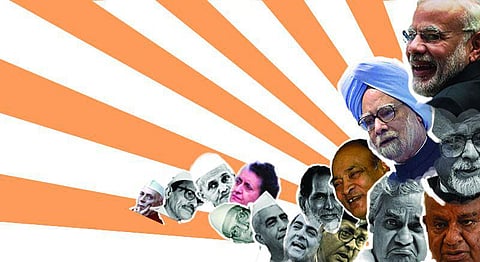
- HOMEGROWN WORLD
- #HGCREATORS
- #HGEXPLORE
- #HGVOICES
- #HGSHOP
- CAREERS
- ABOUT US
- CONTACT US

How is the Prime Minister elected?
As the General Elections Results draw closer, so do the questions: Which party will win majority? Who will be our next prime minister? Who should I vote for?
One of the most frequently asked questions is: “How is the prime minister appointed?” In the frenzy of political party campaigning and social media wars, we often forget about a small paragraph tucked away in our old civic textbooks: the appointment of a prime minister. This election, before putting in your vote, make sure you know how your vote will affect the appointment of India’s next Prime Minister! Here’s a simple, condensed version to help you through it.
India is a democracy, which quite simply means that the citizens choose their own leaders. While State and Assembly elections deem this true, there are a few more layers to it. Not all leaders are elected directly by the citizens. For instance, members of the Rajya Sabha (upper house) are elected by Members of the Legislative Assemblies (MLAs). These MLAs, on the other hand, are elected directly by voting in the State Elections. Similarly, the Prime Minister of India is not elected directly by the citizens of the country.
How is the Prime Minister appointed?
The Prime Minister of India, to put it directly, is the leader of the Political Party that wins a majority in the General Elections. To win majority, a party must bag at least 272 seats out of the total 543 seats of the Lok Sabha. The leader of the party is then formally appointed as the Prime Minister by the President of India. For instance, Bharatiya Janata Party (BJP) won majority in the Lok Sabha Seats in the 2014 General Elections. Accordingly, Narendra Modi, who is the leader of the Party, was appointed as the Prime Minister. Hence, there is no separate elections held to elect the Prime Minister.
Can any leader be appointed as the Prime Minister?
For a party leader to be eligible for the appointment of Prime Minister, he must be a member of either the Lok Sabha or the Rajya Sabha. Then, he must contest the election for a seat from a particular locality as a Member of Parliament. For instance, in the upcoming 2019 elections, BJP has announced that Party Leader Narendra Modi will contest from Varanasi seat.
What if no party wins a majority?
In case no political party is able to win a clear majority, there arises something called a “hung parliament.” In the case of a hung parliament, different parties form coalitions until they get the requisite amount of seats to form a majority. Then, they can nominate a leader who will be appointed as a Prime Minister. The interesting part is if it’s not possible to form any coalitions, President himself uses his authority to appoint the Prime Minister as a leader who seems capable of running a stable government. This is one of the few instances where Present gets to use his authority.
A common myth is that the Prime Minister can hold his office as long as his party enjoys five years of tenure. However, this is not true! If majority of the Lok Sabha is unhappy with the Prime Minister, they can remove him with a no-confidence vote.
This election, we encourage you to exercise your vote responsibly. Read up, learn and vote for a better India!
If you enjoyed reading this article, we just suggest you read:
